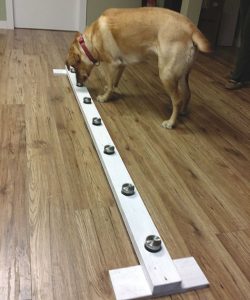
Dana, a yellow Labrador dog, sniffs for an object hidden in one of the containers on a wooden rack. Once she has found the container that holds the object, she will alert the trainer to indicate the correct container. She does this by either sitting, or lying down or pawing at the container. That is the very beginning stages of this type of training with these dogs. That stage will take 12-18 weeks of training and is not used with cancer cells.
March 25, 2017
Richard Froese
Spotlight
Dogs are being recruited to detect cancer in humans by a woman who recently became a certified trainer.
After obtaining a certification to train dogs in bio detection, such as early stage cancer and other diseases, Liz Dick of Langdon AB, is now starting with a small group of dogs, says a news release dated March 10.
Over the next few months, she will speak at various clubs and organizations about how trained dogs could help save lives.
“The level of training the dog has had previously in basic scent detection will determine which stage they are at in order to move ahead in more specialized training in the medical detection field,” Dick says.
“A specially-trained dog can distinguish between malignant and benign instantly with an accuracy of over 90 per cent.
“It is important to understand that a dog will not replace an imaging machine, the dogs are doing totally different work using olfaction.”
A dog is certainly accepted into the program if it has no previous training in any form of scent detection.
“It just means that once accepted, their training would start at a different level than a dog that comes into the program already with the basics of scent detection training,” Dick says.
Typically, herding breeds such as shepherds and border collies work well, along with retrievers such as labs and golden labs, will normally enjoy this type of job.“
I have heard of a Papillion that is superb at detecting Parkinson’s disease and a Skye terrier, that is exceptionally accurate at detecting early-stage cancers,” Dick says.
“So, it is not so much the breed of the dog, but more the attitude and drive that the dog has toward this line of work.
“It must always be a fun and exciting thing in the dog’s point of view.”
She says the ideal dog has some required characteristics.
“It’s extremely important to assess the dog’s disposition before training ever begins, as different dogs might need different training methods,” Dick says.
“Some dogs like an excited handler and others like a calmer handler.”
To detect disease, dogs are not close to the patient.
“Rest assured that these specially trained dogs will not be smelling the bodies of people directly,” Dick says.
“There will never be contact between the dog and the patient as the dog smells only samples of patients’ breath, urine, saliva, sweat, and blood that have been taken at a controlled facility and shipped to the laboratory, where the dogs will smell each sample individually.”
Community groups interested in hearing Dick speak on the topic of dogs that detect cancer and other diseases may contact her by phone or text at (1-587) 223-3979 or email to liz.dick212@gmail.com.








